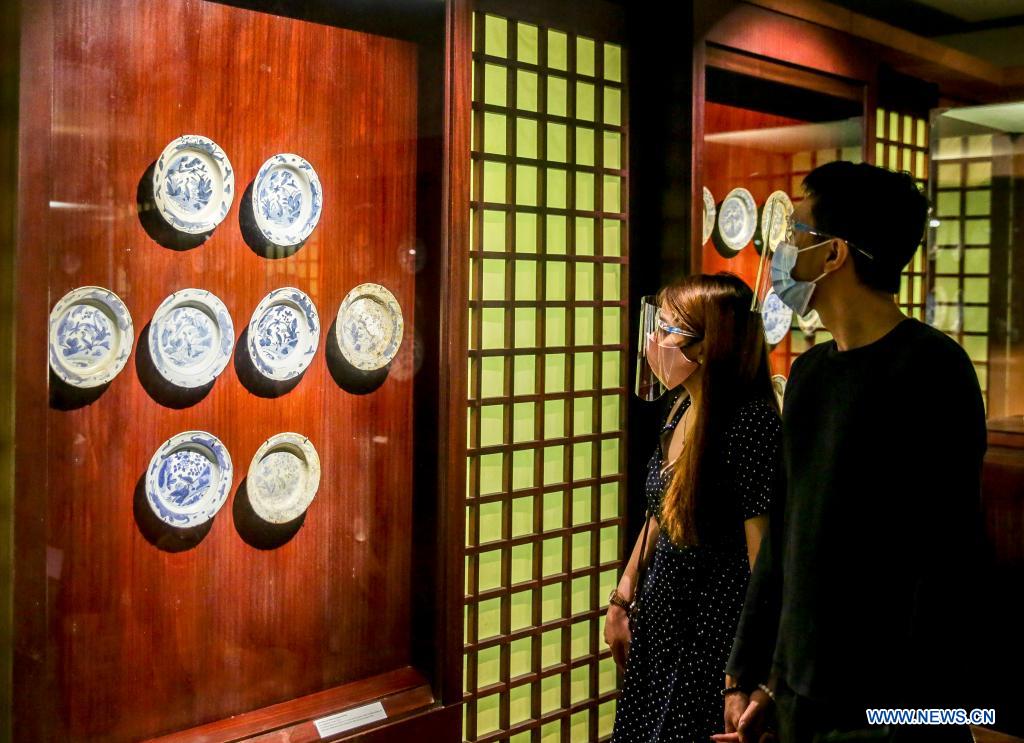Ancient Chinese ceramics in Philippine museum witnesses Quanzhou's glory along Maritime Silk Road
 0 Comment(s)
0 Comment(s) Print
Print E-mail Xinhua, July 26, 2021
E-mail Xinhua, July 26, 2021

Bobby Orillaneda, a senior researcher of the Philippine National Museum of Anthropology, fell in love with ancient Chinese ceramics in 1999 when he joined a shipwreck excavation in Palawan, an archipelagic province in the Southeast Asian country.
As a ceramic researcher and head of the museum's maritime and underwater heritage division, Orillaneda said China's ceramics collections of the museum date back to nearly 1,000 years ago or the Southern Song and Yuan dynasties.
The ancient Chinese ceramics, most of which were found in the Philippines either inland sites or in shipwreck sites, are "very good evidence of the thriving maritime trade between China and the rest of the world, including the Philippines," he told Xinhua in an interview.
"Most of the collections here are from the port of Quanzhou since the 13th century, when there was increased maritime traffic among China, the Philippines, and the rest of the Southeast Asian region. Ceramics from different areas of China would be carried to Quanzhou first and then shipped towards different destinations such as here in the Philippines," Orillaneda said.
Over the past years, Orillaneda has visited many cities in China to arrange cultural artifacts exhibitions. Among those cities, Quanzhou, located in China's Fujian province as the crucial starting point of the ancient Maritime Silk Road, impressed him the most.
Dating back to China's Song Dynasty (960-1297) and Yuan Dynasty (1271-1368), Quanzhou witnessed a prospering maritime trade and economy, serving as a bridge for cultural exchange and mutual learning between China and the rest of the world.
On Sunday, Quanzhou: Emporium of the World in Song-Yuan China, was added to the UNESCO World Heritage List as a cultural site, bringing the total number of China's UNESCO World Heritage sites to 56.
Starting from Quanzhou, silk, porcelain, and tea were ferried out of China, while spices, exotic plants, and other rare treasures were shipped back.
Shipwrecks excavated in Quanzhou Bay and the South China Sea also testify to the prosperity and vibrancy of the port, such as the wreck of a sailing ship with a wooden hull unearthed in Houzhu Harbor in Quanzhou Bay.
This three-masted ocean-going commercial vessel seems to have been originally built in Quanzhou in the 13th century, and at the time of the wreck, it was returning from Southeast Asia loaded with spices, medicines, and other merchandise.
Deeply engrossed in the study of ancient Chinese ceramics, Orillaneda said that out of all the collections in the Philippine National Museum of Anthropology, his favorite one is a blue and white porcelain bowl made during the Yuan Dynasty.
"It is recovered from a late 15th-century shipwreck here in Palawan, but this one is quite different because it is made during the Yuan Dynasty, which is about 100 years earlier than the shipwreck," Orillaneda said.
"During the Yuan Dynasty, the blue and whites are of very high quality. The cobalt was taken from Central Asia and imported to China and used during the first batch of the blue and whites. Therefore, the exquisite craftsmanship and the colors are very vibrant. The design inside the bowl shows mythical animals like phoenix and kylin, which are important symbols in Chinese mythology."
Orillaneda's mentor, Rita Tan, the former president of the Oriental Ceramic Society of the Philippines, also dedicated her life to studying ancient Chinese ceramics.
Born in 1939, Tan has been the curator of a series of exhibitions on overseas ancient Chinese ceramics, particularly those fabricated in Fujian province before being shipped out from Quanzhou and finally discovered in the Philippines.
She attributed the discovery of Song-Yuan ceramics in the Philippines to Chinese government policy incentives of those dynasties and the Philippines' strategic location along the Maritime Silk Road due to its proximity to China's coastal areas. Tan believes that these cultural relics are "the most concrete evidence of history."
"Song Dynasty is the 'golden era' of Chinese ceramics, which witnessed the blooming of kilns in Southeast China. Moreover, the opening-up policy and emphasis on foreign trade of those dynasties boosted the export of Chinese ceramics," Tan said.
"Geographically close, the Philippines is a must-pass between China and the rest of the Southeast Asian region, and even Western Asia," Tan added.
d79bfebb-e4c6-40e6-90a9-9c7503eb67b6.jpg)




Go to Forum >>0 Comment(s)